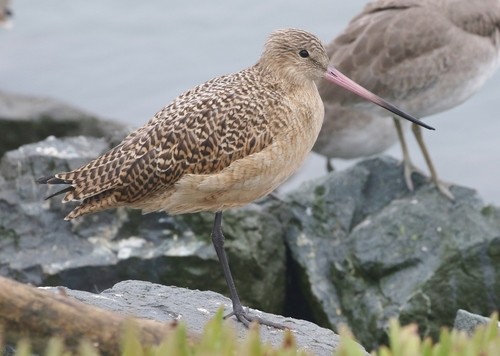Marbled Godwit
A species of Godwits, Also known as Marwit Scientific name : Limosa fedoa Genus : Godwits
Marbled Godwit, A species of Godwits
Also known as:
Marwit
Botanical name: Limosa fedoa
Genus: Godwits
 Photo By silversea_starsong , used under CC-BY-NC-4.0 /Cropped and compressed from original
Photo By silversea_starsong , used under CC-BY-NC-4.0 /Cropped and compressed from original Description
The total length is 40–50 cm (16–20 in), including a large bill of 8–13 cm (3.1–5.1 in), and wingspan is 70–88 cm (28–35 in). Body mass can vary from 240 to 510 g (8.5 to 18.0 oz). Adults have long blue-grey legs and a very long pink bill with a slight upward curve and dark at the tip. The long neck, breast and belly are pale brown with dark bars on the breast and flanks. The back is mottled and dark. They show cinnamon wing linings in flight. 
Size
46-48 cm (18-19 in)
Colors
Brown
Black
Gray
White
Life Expectancy
14 years
Nest Placement
Ground
Clutch Size
3 - 5 eggs
Incubation Period
1 brood
Number of Broods
23 - 26 days
Nestling Period
1 day
Feeding Habits
Marbled Godwit's diet includes aquatic invertebrates, earthworms, insects, mollusks, crustaceans, plant tubers, leeches, and small fish. They probe mud or sand to forage, picking prey from the surface or submerging their head, even in water up to 5 inches deep.
Habitat
Marbled Godwit inhabit wetlands, preferring shortgrass prairies for breeding, especially with green needle grass, western wheatgrass, and blue grama. They avoid taller vegetation. During the non-breeding season, they frequent coastal habitats like mudflats, estuaries, and sandy beaches. Their selected habitats are consistent, generally avoiding forested or urban areas.
Nest Behavior
The female marbled Godwit selects one of the male's depressions to lay eggs. Nesting activities occur far from water, with incubation and parental care jointly managed by both parents after egg-laying.
Nest Characteristics
Marbled Godwit's nest is a shallow depression on the ground with little cover, found in shortgrass prairies. It's lined with grasses and lichen, formed primarily by the male creating several depressions.
Dite type
Aquatic invertebrate eater
People often ask
Migration Overview
Marbled godwits breed in three distinct areas with their own unique route. The vast majority occur in mid-continental North America, followed by eastern Canada and the Alaska Peninsula, USA. In addition, the largest winter ranges are the Atlantic, Pacific and Gulf coasts of the US and Mexico. Godwits breeding in the western USA and Canada follow a route through the Utah stopover site, with a final arrival in the winter sites of Mexico and the Caribbean. Species breeding in eastern Canada migrate across the US, and stopover at sites along the Gulf of California and Mexico. Furthermore, those breeding in North and South Dakota winter in coastal Georgia. The Bear River Migratory Bird Refuge located at Great Salt Lake in Utah (USA), is one of the most popular stopover sites for godwits in the spring and fall. 
General Info
Feeding Habits
Bird food type
Behavior
Marbled Godwit exhibit various behaviors that are integral to their survival and breeding. These birds engage in wading through shallow waters, occasionally swimming, or traversing shortgrass prairies. They display recognizable flight patterns with a sharp profile and pointed wings, often sleeping while standing on a single leg with their bill tucked in. During breeding, males establish expansive territories and perform impressive flight displays to court mates, emphasizing their monogamous bonds. Post-breeding season, marbled Godwit remain loyal to their breeding areas and partners annually. In nonbreeding seasons, they forage in groups alongside other shorebirds, showcasing their adaptability and social nature within their ecosystem.
Species Status
Their numbers were reduced by hunting at the end of the 19th century. Although they had recovered somewhat since that time, their population has declined in recent times as suitable habitat is used for farming. 
Scientific Classification
Phylum
Chordates Class
Birds Order
Shorebirds Family
Sandpipers Genus
Godwits Species
Marbled Godwit